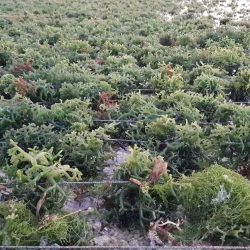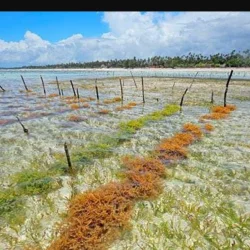
Farmers struggle amid declining seaweed exports
Despite increasing national seaweed production, Indonesian seaweed farmers have been struggling to market their product, particularly in the wake of a significant drop in demand from overseas markets over the past several months. Speaking to reporters recently on the sidelines of a discussion in Makassar, South Sulawesi, Indonesia Seaweed Industry Association secretary Arman Arfah said the significant decline in overseas demand for Indonesian seaweed had started since earlier this year after China, the main export destination for Indonesian seaweed, ceased imports, having stockpiled a huge volume of the commodity.
The government must build warehouses in seaweed production centers to store the surplus,' Arman said. Indonesia is the world's biggest producer of seaweed, especially the gracillaria variety; last year, the country produced 10.2 million tons of seaweed, with some 30 percent exported to foreign markets. The domestic market, however, could only absorb 40 percent of national seaweed production, leaving the remaining 30 percent unabsorbed.
To store the unabsorbed production, and to anticipate future harvest failures, Arman said the government needed to build at least 30 seaweed storage facilities across the archipelago, each with the capacity to store 500 tons of seaweed. The price of standard-quality seaweed currently stands at between Rp 3,000 (25 US cents) and Rp 3,500 per kilogram, a sharp drop from Rp 9,000 per kg earlier this year. High-quality seaweed, meanwhile, is now priced at around Rp 6,000 per kg.
Seaweed farmer Bakhtiar, 48, from Wajo regency, South Sulawesi, said that demand for and the price of seaweed had dropped since June this year. Bakhtiar, who owns a 3.5-hectare seaweed farm, said seaweed buyers had stopped coming to buy local farmers' yield, forcing producers to market the commodity themselves.
When the seaweed price is normal, traders come to farmers. But since several months ago, farmers have to go to the traders,' he said. South Sulawesi is one of the biggest seaweed production centers in the country, especially of the gracillaria variety. National production of gracillaria seaweed reaches up to 1 million tons annually, with some 800,000 tons coming from South Sulawesi.
Gracillaria seaweed is mostly exported to China, with the domestic industry only absorbing a small volume, because seaweed processing plants are only available in Java. The domestic seaweed industry tends only to use the eucheuma cottonii and spinosum varieties. The general director for aquaculture at the Maritime Affairs and Fisheries Ministry, Slamet Soebijakto, meanwhile said the government and local seaweed industry should work together to open new markets for the commodity.
We have made efforts to open new markets, such as Chile and the Philippines. The Chinese market is opening up again too, but we also hope the domestic industry will grow and increase utilization,' he said.
This article was published in thejakartapost.com with the title "Farmers struggle amid declining seaweed exports".
The government must build warehouses in seaweed production centers to store the surplus,' Arman said. Indonesia is the world's biggest producer of seaweed, especially the gracillaria variety; last year, the country produced 10.2 million tons of seaweed, with some 30 percent exported to foreign markets. The domestic market, however, could only absorb 40 percent of national seaweed production, leaving the remaining 30 percent unabsorbed.
To store the unabsorbed production, and to anticipate future harvest failures, Arman said the government needed to build at least 30 seaweed storage facilities across the archipelago, each with the capacity to store 500 tons of seaweed. The price of standard-quality seaweed currently stands at between Rp 3,000 (25 US cents) and Rp 3,500 per kilogram, a sharp drop from Rp 9,000 per kg earlier this year. High-quality seaweed, meanwhile, is now priced at around Rp 6,000 per kg.
Seaweed farmer Bakhtiar, 48, from Wajo regency, South Sulawesi, said that demand for and the price of seaweed had dropped since June this year. Bakhtiar, who owns a 3.5-hectare seaweed farm, said seaweed buyers had stopped coming to buy local farmers' yield, forcing producers to market the commodity themselves.
When the seaweed price is normal, traders come to farmers. But since several months ago, farmers have to go to the traders,' he said. South Sulawesi is one of the biggest seaweed production centers in the country, especially of the gracillaria variety. National production of gracillaria seaweed reaches up to 1 million tons annually, with some 800,000 tons coming from South Sulawesi.
Gracillaria seaweed is mostly exported to China, with the domestic industry only absorbing a small volume, because seaweed processing plants are only available in Java. The domestic seaweed industry tends only to use the eucheuma cottonii and spinosum varieties. The general director for aquaculture at the Maritime Affairs and Fisheries Ministry, Slamet Soebijakto, meanwhile said the government and local seaweed industry should work together to open new markets for the commodity.
We have made efforts to open new markets, such as Chile and the Philippines. The Chinese market is opening up again too, but we also hope the domestic industry will grow and increase utilization,' he said.
This article was published in thejakartapost.com with the title "Farmers struggle amid declining seaweed exports".




